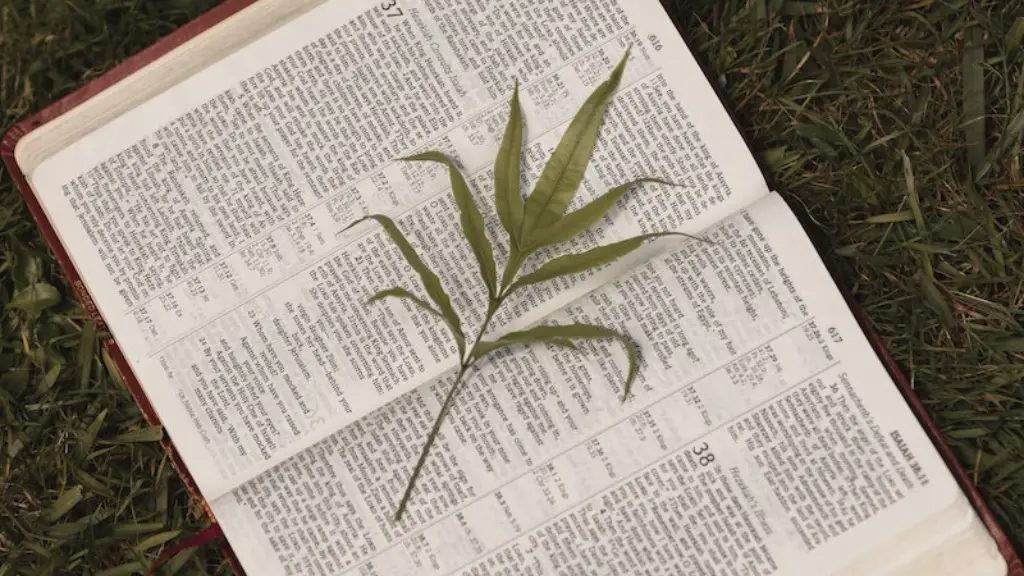Hyssop is a versatile plant that is mentioned many times in the Bible. It was used for a variety of purposes, including purification, cleansing, and healing.
Hyssop is mentioned in several places in the Bible, usually in connection with cleansing or purification. For example, in Leviticus 14, hyssop is one of the materials used in the process of cleansing a leper. In Psalm 51, David asks God to cleanse him with hyssop, and in John 19, hyssop is used to cleanse the blood of Jesus from the cross.
What did God say about hyssop?
Hyssop is a plant that was used for purification in the Bible. It was used to cleanse people and objects from impurities. It was also used to symbolically cleanse people from their sins. The sixth reference to hyssop in the Bible is during Jesus’ crucifixion when Hyssop was dipped in vinegar and wiped across Jesus’ lips to ease the suffering.
He wrote, “Cleanse me with hyssop, and I will be clean; wash me, and I will be whiter than snow”.
Hyssop was a small, brush-like plant in Israel. It’s mentioned in connection with the Passover; the Israelites used it to spread blood on the doorframes of their homes (Exodus 12:21-22).
This verse is from Psalm 51, a poem about repentance. The writer is asking God to cleanse him, and compares himself to being covered in dirt and grime. Just as the Israelites were cleansed with the blood of a lamb during the Passover, he is asking to be cleansed of his sins.
What are the benefits of hyssop
Hyssop is a herb that has a long history of use in traditional medicine. It is rich in nutrients and essential oils that offer some helpful health effects. For example, hyssop is rich in flavonoids, flavorful compounds that can act as antioxidants. Eating foods rich in flavonoids may help reduce your risk of age-related conditions like cataracts, heart disease, and strokes.
The hyssop flower is a traditional symbol of humility, repentance, health, and sacrifice. Its meaning is deeply rooted in religious and spiritual traditions, and it continues to be a popular choice for those seeking to express these qualities in their lives.
What is hyssop called today?
Hiope, also known as Herbe de Joseph, Herbe Sacrée, Herbe Sainte, Hiope, Hisopo, Hissopo, Hyssopus officinalis, Hysope, Hysope Officinale, Jufa, Rabo De Gato, and Ysop, is a plant that has a long history of use in herbal medicine. Hiope is native to the Mediterranean region and has been used medicinally for centuries. The plant is a member of the mint family and has a strong, aromatic flavor. Hiope is used to treat a variety of conditions, including cough, cold, flu, and bronchitis. Hiope is also used as an expectorant and to treat digestive disorders.
Hyssop has a long history of being used as a cleansing herb, particularly for temples and other sacred places. In ancient times, the Hebrew people called this herb azob, meaning “holy herb.” Today, hyssop is still used in some religious ceremonies and is considered to have purifying and protective properties.
What did God say about herbs in the Bible?
The Vulgate is a translation of the Bible into Latin that was completed in the late 4th century. This particular verse is from the Book of Genesis. In it, God tells Noah and his family that they are allowed to eat any plant or fruit as long as it has a seed. This is a reminder that we are to be thankful for the food we have been given.
The plant I’m talking about is anise. It’s a lovely plant with pretty, fragrant leaves. I enjoy weeding around it because it releases a sweet, light licorice smell. You can use the leaves in chicken, cookies, and other recipes, as well as in herbal tea and other beverages.
What is the Psalms prayer for cleansing
Lord, have mercy on me according to your unfailing love. Blot out my transgressions and cleanse me from my sin. I know my transgressions and my sin is always before me. Wash away all my iniquity and cleanse me from my sin.
Hyssop is a medicinal herb that has a long history of use in treating a variety of ailments. Side effects from taking hyssop are usually mild and include gastrointestinal upset, anxiety and tremors. However, hyssop may exacerbate seizure disorders, particularly in children when given as oil. If you are considering taking hyssop for any reason, be sure to talk to your healthcare provider first to ensure it is safe for you.
Can you drink hyssop oil?
Hyssop oil is not meant to be ingested, despite its use as a folk remedy for gastrointestinal upset. Ingesting hyssop oil may actually cause gastrointestinal issues.
If you are considering using hyssop for its medicinal properties, be aware that it may cause some side effects like upset stomach, anxiety, and tremors. While these effects are typically mild, be sure to speak to your healthcare provider if you have any concerns. As always, practice safety when using any herb and never exceed the recommended dosage.
What flower is hyssop
Hyssop is a versatile plant that can be used for a variety of purposes. The leaves and flowers have a strong aroma and can be used to flavor food and drink. Additionally, the plant has a long history of use in folk medicine.
Hyssopus officinalis is a native Mediterranean plant that has naturalized in North America. It can be found growing on roadsides in southern Canada and parts of the northern US. This plant is known for its medicinal properties and has been used to treat a variety of ailments.
Is Lavender the same as hyssop?
Hyssop (Hyssopus officinalis) is a perennial herb that belongs to the mint and sage family (Lamiaceae). It is mostly aromatic and has many similarities to lavender. The leaf shape, in particular, is quite similar but the leaf color is greener than lavenders’.
The Bible is one of the oldest and most important books in human history. It is also one of the most significant books in terms of its impact on medicine and health. The Bible contains many references to medical and health-related topics, including the use of medicinal plants.
Only five species are mentioned directly as medicinal plants in the Bible: Fig (Ficus carica), Nard (Nardostachys jatamansi), Hyssop (Origanum syriacum), balm of Gilead (Commiphora gileadensis) and Mandrake (Mandragora officinarum).
All of these plants have been used medicinally for centuries and have been shown to be effective for a variety of conditions. Fig has been used to treat digestive problems, Nard has been used as an insect repellent and to treat skin conditions, Hyssop has been used to treat respiratory infections, and balm of Gilead has been used to treat wounds and skin conditions.
The Bible is a powerful book that has had a profound impact on human health and medicine. The five medicinal plants mentioned in the Bible are just a small example of the many plants that have been used medicinally throughout history.
Warp Up
There are a couple of instances in the Bible where hyssop is used. In Exodus, when God was going to strike down the firstborn in Egypt, he told Moses to have each household smear some blood on their doorposts using a bunch of hyssop. This would protect them from the death angel. Later, when David was running from King Saul, he asked for a drink of water from a well. The only thing available to dip the water out with was a hyssop branch.
The Bible mentions hyssop a few times, usually in relation to cleansing or purification. In Exodus, the Israelites were instructed to use hyssop branches to apply the blood of a sacrificed lamb to their doorframes, so that their homes would be spared from the plague. In Leviticus, hyssop is one of the plants that should be used in the cleansing of a leper. And in Psalms, David cries out to God to cleanse him with hyssop, and his prayer is answered.





